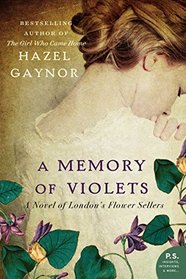Helpful Score: 1
Let me start with: I LOVED THIS BOOK! London in the late 1800's, the severe poverty of many, and the plight of the children of the slums. Women and children living in the slums of London, sell flowers to the well to do suffering through the filth and climate to scratch out a living. Two Irish girls growing up with an abusive father after their mother dies, are basically on their own. Many of these children are crippled either at birth due to disease or by accidents incurred by working in factories. Rosie & Florie hawk their flowers - Rosie with very limited eyesight, Florie using a crutch to walk and taking care of her younger sister. Rosie gets separated from Florie and disappears in the crowd. What follows is a heartbreaking and uplifting story told between the late 1800's and early 1900's. Based on historical facts. Excellent read if you like historical fiction and strong female characters!
Very interesting story of 2 little girls who sell flowers on the filthy streets of London to survive. (Think "My Fair Lady"). Very well researched, by the author of "The Girl Who Came Home"--one of my favorite books.
This is a captivating, heartbreaking story about two handicapped, dirt poor girls, 8 yr old Florrie with a useless leg due to polio and 4 yr old blind, Rosie in 1879. They live with an abusive father when their mother dies.in the late 1800's. They sell flowers in the streets of London and get beaten by their father when they don't bring enough money. One day someone tries to grab Rosie who runs away as the sisters get separated and the story flows from there.
The chapters alternate between 1879 and 1912 when Tilly leaves her home where she feels unloved, to work in an orphanage for crippled and blind girls as an assistant housekeeper in London. She gets caught up in Florrie's story when she finds her journal hidden in a closet of her room. She makes a promise to herself to find Rosie if she can.
There are many other characters involved, the girls in the Home For Crippled Children, the housekeepers and staff who take care of the girls, the Founder Albert Shaw, based on the real life of John Groom who made sure these street urchins were taken care of by teaching them the new trade of making artificial flowers; all were endearing and a big part of the story.
I was mesmerized by this book and kept thinking about it; the ending was magical and made me cry.
Highly recommended.
The chapters alternate between 1879 and 1912 when Tilly leaves her home where she feels unloved, to work in an orphanage for crippled and blind girls as an assistant housekeeper in London. She gets caught up in Florrie's story when she finds her journal hidden in a closet of her room. She makes a promise to herself to find Rosie if she can.
There are many other characters involved, the girls in the Home For Crippled Children, the housekeepers and staff who take care of the girls, the Founder Albert Shaw, based on the real life of John Groom who made sure these street urchins were taken care of by teaching them the new trade of making artificial flowers; all were endearing and a big part of the story.
I was mesmerized by this book and kept thinking about it; the ending was magical and made me cry.
Highly recommended.
A beautiful tale of destiny told with captivating detail of the poor flower girls in the Victorian era. Their rich history provides the backdrop to the stories of two young sisters separated and how strangers brought them back together, unsuspecting that they, too, were bonded in ways they could never have anticipated. An absolutely satisfying page-turner that lingered long after I read the last page. 5 stars.
Not as good as I had hoped it would be.
Loved this book.




